quinta-feira, 30 de setembro de 2010
The more you know: switching to Gmail like a pro
Veni, Vidi, Verba Verti
Ut munimenta linguarum convellamus et scientiam mundi patentem utilemque faciamus, instrumenta convertendi multarum nationum linguas creavimus. Hodie nuntiamus primum instrumentum convertendi linguam qua nulli nativi nunc utuntur: Latinam. Cum pauci cotidie Latine loquantur, quotannis amplius centum milia discipuli Americani Domesticam Latinam Probationem suscipiunt. Praeterea plures ex omnibus mundi populis Latinae student.
Hoc instrumentum convertendi Latinam rare usurum ut convertat nuntios electronicos vel epigrammata effigierum YouTubis intellegemus. Multi autem vetusti libri de philosophia, de physicis, et de mathematica lingua Latina scripti sunt. Libri enim vero multi milia in Libris Googlis sunt qui praeclaros locos Latinos habent.
Convertere instrumentis computatoriis ex Latina difficile est et intellegamus grammatica nostra non sine culpa esse. Autem Latina singularis est quia plurimi libri lingua Latina iampridem scripti erant et pauci novi posthac erunt. Multi in alias linguas conversi sunt et his conversis utamur ut nostra instrumenta convertendi edoceamus. Cum hoc instrumentum facile convertat libros similes his ex quibus edidicit, nostra virtus convertendi libros celebratos (ut Commentarios de Bello Gallico Caesaris) iam bona est.
Proximo tempore locum Latinum invenies vel auxilio tibi opus eris cum litteris Latinis, conare hunc.
terça-feira, 28 de setembro de 2010
Google Places Tip and Tricks - September
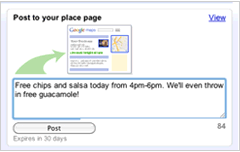
Post to your Place page
Connect with your customers through Place page posts. These 160-character posts allow you to share a short update or special with users. Check out some examples and sign in now to write a quick post!
Make sure your free listing has everything it needs
You can update your business hours, add photos and make many other edits through your Google Places account. Some of the information you can update includes:
- Photos and videos
- Business hours
- Description
- Address and service areas
- Much more
- Duplicate listings
- Inaccurate information, including personal contact information or information about another business, that appears on your Place page
Success Story

Through Google Places, Dr. Jeffrey Prager's Bellinghamsmiles.com Dental Care has a continual influx of new customers, reduced marketing costs, and a high ROI.
As his practice continues to evolve, he updates his Place page to reflect any new services he offers. He might add a new video or update his business description. The listing also helps him market his business niche - laser procedures to help patients avoid painful gum surgery. Read more.
You can update your Places account at any time by signing in at http://google.com/places with your email address and password.
Posted by Bernadette Cay, Associate Product Marketing Manager
segunda-feira, 27 de setembro de 2010
Event recap: How to run a successful social campaign
Last week, YouTube and SEMPO hosted a social marketing panel, "How to run a successful social campaign," for SEMPO's San Francisco and Los Angeles working groups. The panel featured speakers from YouTube, Facebook, Twitter, and Athena East, and highlighted the unique products available to marketers, and best practices for executing measurable, impactful social advertising strategies.
Derek Gordon of Yield Software was there, and shared what he learned in today's Mediapost Search Insider column.
Click here for his complete update.
Posted by AgencyAd Solutions Blog Team
sexta-feira, 24 de setembro de 2010
Finding your hidden treasure: international campaigns with AdWords
In 2000, Antoine Assi founded Middle Eastern export website www.aldoukan.com—it was one of the first e-commerce business in the Middle East. He was just 20 years old and he made time to develop the business in between computer science classes at his university. He needed a way to advertise his website from the comfort of his own dorm room, so he decided to test out Google AdWords.
His friends didn’t believe him when Antoine said he was going to sell and advertise traditional Middle Eastern foods and goods online. However, by 2004, his business had grown so rapidly that he decided to take leave from school to run it full-time. He then started his second company, www.mosaicmarble.com, which sells handcut decorative tiles online internationally.
Antoine believed there was a gap in the mosaic market and he wanted to share these artistic and historic decorations abroad. He knew there was a market for these tiles internationally—he just didn’t quite know where the opportunity existed. To identify these international growth opportunities, Antoine built on his knowledge of AdWords: He ran several AdWords campaigns, each targeted at the location and language of the test country.

From there, Antoine measured sales and percentage of website traffic from each country and campaign. He ended campaigns for countries with low sales volume and invested in campaigns for countries with higher sales volume and greater return on investment. Where he saw steady product sales, Antoine even had the company website translated into the language of the successful host country. As you can imagine, translating the site to the language of a country in which he’d already seen success only further promoted sales in that location.
Antoine refers to his AdWords campaigns as his hidden treasure, telling us that “the second month we started advertising on Google, we started feeling overwhelmed by the orders and the inquiries... We had to hire new employees on a weekly basis.”
Mosaic Marble quickly grew from two employees and eight artists to more than 40 employees and 120 artists. And the company’s website is now available in seven languages: Arabic, English, Finnish, German, Italian, Portuguese and French.

In addition to helping him expand his business, these international campaigns helped Antoine and his colleagues share these cultural icons with a larger part of the world. There are now homes and public spaces adorned with these ancient Greek creations in more than 50 countries worldwide. “Due to Google,” says Antoine, “we have customers such as the President of Congo, the Dubai Minister of Internal Affairs, the Princess of Jordan, and the Royal Music Academy of London.”
Posted by Elias Darwish, Account Manager, Dublin
Going Google across the 50 States: Connecticut-based ice cream franchise decides to ‘gofer’ Google Apps
quarta-feira, 22 de setembro de 2010
How to edit Google Maps and local business listing data
The world is a big place that’s constantly changing, so in digitally replicating it on Google Maps, you can imagine how much information we’re working with. We get data for Google Maps from a number of sources, including third party providers, business owners and users like yourself. And while for the most part, our algorithms do a great job of accurately reflecting the real world on the map, there are some instances when we get it wrong.
If you notice something that’s incorrect on Google Maps, chances are it’s either an issue with our map data - things like city and road names - or with our business listing data. We have a number of simple tools that make it easy for you to correct or report any issues so that we can get the maps right. Your assistance helps us provide the most accurate and up-to-date maps possible, so you and other Google Maps users can find what you’re looking for and be on your way.
Report a problem with our map data
Use the Report a Problem tool in the U.S. and Canada, most easily accessible by right-clicking on the map or clicking the link on the bottom right-hand-side of the map. If anything with our map data is wrong, such as a road being renamed or a new highway on-ramp opening up, please submit a report. We work hard to fix the map based on user submissions, and try to resolve these issues as fast as we can. Countries outside the U.S. and Canada should contact the Google Maps data provider to correct the information.
Edit business listing information directly on Maps
If you see incorrect information appearing on Google Maps listings in the U.S. (and many more countries), you can make updates to listings directly on Google Maps. Once we've reviewed your edits, updates to the listing will go live within several hours. If you are the business owner but have yet to claim your listing, see below for more information about Google Places.
Report incorrect business listing information
The best way to report incorrect information is to use the “Report a Problem” tool, where available. Report a Problem allows you to specify exactly what is incorrect about a listing. Once these user-submitted reports are reviewed, updates to the listing will go live in a few weeks.
If you’re a business owner, you should also claim your Google Places listing so that you can edit and update the listing that appears on Google, Google Maps and GOOG-411. Verifying your free business listing allows you to not only ensure that accurate information appears on the Place page for your business, but also enhance your online presence by adding photos, videos and even real-time updates like weekly specials to your Place page.
Claim your Google Places listing
Claim your Google Places listing by adding it at http://www.google.com/places or by clicking “Business Owner?” on the Place page for your business. Verify your listing by PIN (postcard or phone). Within an hour, click the “See your listing on Google Maps” link in your account to see your listing’s Place page. If incorrect information is appearing in your listing, there are a number of different ways to let us know and get the information corrected.
Posted by Brianna Brekke, Senior Strategist, Google Places
terça-feira, 21 de setembro de 2010
Strengthen your advertising strategies with the Train & Gain challenge

segunda-feira, 20 de setembro de 2010
A more secure cloud for millions of Google Apps users
sexta-feira, 17 de setembro de 2010
Remembering Fred Jelinek
It is with great sadness that we note the passing of Fred Jelinek, teacher and colleague to many of us here at Google. His seminal contributions to statistical modeling of speech and language influenced not only us, but many more members of the research community.
Several of us at Google remember Fred:
Ciprian Chelba:
Fred was my thesis advisor at CLSP. My ten years of work in the field after graduation led me to increasingly appreciate the values that Fred instilled by personal example: work on the hard problem because it simply cannot be avoided, bring fundamental and original contributions that steer clear of incrementalism, exercise your creativity despite the risks entailed, and pursue your ideas with determination.
I recently heard a comment from a colleague, “A natural born leader is someone you follow even if only out of curiosity.” I immediately thought of Fred. Working with him marked a turning point in my life, and his influential role will be remembered.
Bob Moore:
I first met Fred Jelinek in 1984 at an IBM-sponsored workshop on natural-language processing. Fred's talk was my first exposure to the application of statistical ideas to language, and about the only thing I understood was the basic idea of N-gram language modeling: estimate the probability of the next word in a sequence based on a small fixed number of immediately preceding words. At the time, I was so steeped in the tradition of linguistically-based formal grammars that I was sure Fred's approach could not possibly be useful.
Starting about five years later, however, I began to interact with Fred often at speech and language technology meetings organized by DARPA, as well as events affiliated with the Association for Computational Linguistics. Gradually, I (along with much of the computational linguistics community) began to understand and appreciate the statistical approach to language technology that Fred and his colleagues were developing, to the point that it now dominates the field of computational linguistics, including my own research. The importance of Fred's technical contributions and visionary leadership in bringing about this revolution in language technology cannot be overstated. The field is greatly diminished by his passing.
Fernando Pereira:
I met Fred first at a DARPA-organized workshop where one of the main topics was how to put natural language processing research on a more empirical, data-driven path. Fred was leading the charge for the move, drawing from his successes in speech recognition. Although I had already started exploring those ideas, I was not fully convinced by Fred’s vision. Nevertheless, Fred’s program raised many interesting research questions, and I could not resist some of them. Working on search for speech recognition at AT&T, I was part of the small team that invented the finite-state transducer representation of recognition models. I gave what I think was the first public talk on the approach at a workshop session that Fred chaired. It was Fred’s turn to be skeptical, and we had a spirited exchange in the discussion period. At the time, I was disappointed that I had failed to interest Fred in the work, but later I was delighted when Fred became a strong supporter of our work after a JHU Summer workshop where Michael Riley led the use of our software tools in successful experiments with a team of JHU researchers and students. Indeed, in hindsight, Fred was right to be skeptical before we had empirical validation for the approach, and his strong support when the results started coming in was thus much more meaningful and gratifying. Through these experiences and much more, I came to respect immensely Fred’s pioneer spirit, vision, and sharp mind. Many of my most successful projects benefited directly or indirectly from his ideas, his criticism, and his building of thriving institutions, from CLSP to links with the research team at Charles University in Prague. I saw Fred last at ACL in Uppsala. He was in great form, and we had a good discussion on funding for the summer workshops. I am very sad that he will not be with us to continue these conversations.
Shankar Kumar:
Fred was my academic advisor at CLSP/JHU and I interacted with him throughout my Ph.D. program. I had the privilege of having him on my thesis committee. My very first exposure to research in speech and NLP was through an independent study that I did under him. A few years later, I was his teaching assistant for the speech recognition class. Fred's energy and passion for research made a strong impression on me back then and continues to influence my work to this day. I remember Fred carefully writing up his ideas and sending them out as a starting point to our discussions. While I found this curiously amusing at the time, I now think this was his unique approach to ensure clarity of thought and to steer the discussion without distractions. Fred's enthusiasm for learning new concepts was infectious! I attended several classes and guest lectures with him - graphical models, NLP, and many more. His insightful questions and his active participation in each one of these classes made them memorable for me. He epitomized what a life-long learner should be. I will always recall Fred's advice on sharing credit generously. In his own words, "The contribution of a research paper does not get divided by the number of authors". By his passing, we have lost a role model who dedicated his life to research and whose contributions will continue to impact and shape the field for years to come.
Michael Riley:
I got to know Fred pretty well having attended two of the CLSP six-week summer workshops, working on a few joint grants, and visiting CLSP in between. If there is a ‘father of speech recognition’, its got to be Fred Jelinek - he led the IBM team that invented and popularized many of the key methods used today. His intellect, wide knowledge, and force of will served him well later as the leader of the JHU Center for Language and Speech Processing - a sort of academic hearth where countless speech/NLP researchers and students interacted over the years in seminars and workshops. I was impressed that at an age when many retired and after which most of his IBM colleagues had gone into (very lucrative) financial engineering, he remained a vigorous, leading academic. Fernando mentioned the initial skepticism he had for our work on weighted FSTs for ASR. Some years later though I heard that he praised the work to my lab director, Larry Rabiner, on a plane ride that likely helped my promotion shortly thereafter. And no discussion of Fred would be complete without a mention of his inimitable humor, delivered in that loud Czech-accented voice:
Riley [at workshop planning meeting]: “Could they hold the summer workshop in some nicer place than Baltimore to help attract people?”
Fred: “Riley, we’ll hold it in Rome next year and get better people than you!”
Seminar presenter: [fumbling with Windows configuration for minutes].
Fred [very loud]: “How long do we have to endure this high-tech torture?”
The website of The Johns Hopkins University’s Center for Language and Speech Processing links to Fred’s own descriptions of his life and technical achievements.
Google and The Globe and Mail Launch "Web Strategy" Resources for Canadian Small Businesses
With the proliferation of the Internet, it’s easier than ever for entrepreneurs and small business owners like you to reach new customers, promote your products, and access new markets in ways that only large corporations could manage in the past. For example, powerful and intuitive online applications such Gmail, Google Calendar and Google Docs can help you slash IT costs and enable your employees to collaborate more effectively.
To further this movement towards taking advantage of online resources, we're launching a partnership with The Globe and Mail to help Canadian small business owners and entrepreneurs expand their Web presence and use the Internet to boost sales and long-term growth. The Web Strategy section on The Globe and Mail website will bring together Google's knowledge of business in an online environment with The Globe and Mail’s insight into strategy and economic issues. The site will feature information and stories for small businesses, as well as provide tutorials about how to get started with Google’s many business tools, including Google Places and AdWords.
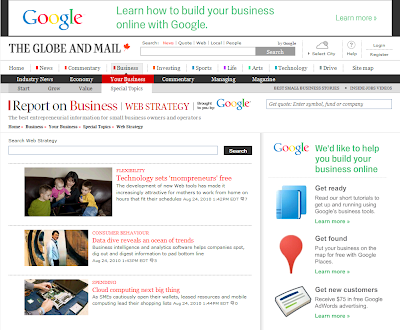
In the coming weeks, the Web Strategy page will explore topics such as how the Internet can transform the ways you reach new customers and how you operate your business. If you have suggestions or questions, we would love to hear them. Click here to use Google Moderator and start sharing your ideas with us.
Posted by Brett Willms, Canada Marketing Manager
Frowns, Sighs, and Advanced Queries -- How does search behavior change as search becomes more difficult?
How does search behavior change as search becomes more difficult?
At Google, we strive to make finding information easy, efficient, and even fun. However, we know that once in a while, finding a specific piece of information turns out to be tricky. Based on dozens of user studies over the years, we know that it’s relatively easy for an observer to notice that the user is having problems finding the information, by watching changes in language, body language, and facial expressions:

Computers, however, don’t have the luxury of observing a user the way another person would. But would it be possible for a computer to somehow tell that the user is struggling to find information?
We decided to find out. We first ran a study in the usability lab where we gave users search tasks, some of which we knew to be difficult. The first couple of searches always looked pretty much the same independent of task difficulty: users formulated a query, quickly scanned the results and either clicked on a result or refined the query. However, after a couple of unsuccessful searches, we started noticing interesting changes in behavior. In addition to many of them sighing or starting to bite their nails, users sometimes started to type their searches as natural language questions, they sometimes spent a very long time simply staring at the results page, and they sometimes completely changed their approach to the task.
We were fascinated by these findings as they seemed to be signals that the computer could potentially detect while the user is searching. We formulated the initial findings from the usability lab study as hypotheses which we then tested in a larger web-based user study.
The overall findings were promising: we found five signals that seemed to indicate that users were struggling in the search task. Those signals were: use of question queries, use of advanced operators, spending more time on the search results page, formulating the longest query in the middle of the session, and spending a larger proportion of the time on the search results page. None of these signals alone are strong enough predictors of users having problems in search tasks. However, when used together, we believe we can use them to build a model that will one day make it possible for computers to detect frustration in real time.
You can read the full text of the paper here.
Going Google across the 50 States: Minnesota-based allnurses.com gets rid of its email servers

quinta-feira, 16 de setembro de 2010
Making AdWords Account Management Easier
As a small business, you may find that investing in marketing can be a catch-22; while you are looking to grow your business, your time is limited and budgets are tight. While AdWords has always been about making advertising as measurable as possible, we are well aware that time is money - especially when you are a small company. So, in an effort to help you preserve your most precious asset, we wanted to share a few of tools we’ve developed as part of our effort to make account management less time-intensive.
Use the Opportunities Tab to Find Customized Account Optimization Suggestions
Incorporating data from both user search behavior and the performance of your own account, the Opportunities tab is an excellent tool for garnering suggestions that can help you to improve targeting, expand your reach or increase the effectiveness of your marketing spend. To make improving your campaigns as easy as possible, the Opportunities tab lets you review ideas and apply them directly to your account. You can also save these ideas as “pending changes” in case you want to think about them and add them later.

The ideas shown on the tab are generated by our system just for your account, so look them over carefully before you try them. Some may not fit your own needs, but some may help to improve your campaign performance.
Automatic Bidding is the easiest of the AdWords bidding options. With automatic bidding, the AdWords system automatically adjusts your maximum cost-per-click (CPC) bids on your behalf. You still set your daily budget, but rather than specifying individual bids for ad groups, keywords, or placements, the AdWords system actively seeks out the most clicks possible within the budget you set.
Let Us Help You Gain More Conversions with Enhanced CPC
Enhanced CPC is an easy-to-use automatic bid management tool intended for advertisers already using conversion tracking who are looking to turbo-charge their return on investment. The tool automatically adjusts your Max CPC bid each time your ad is shown in order to maximize the likelihood of your ad will converting. As a result, your ad should receive more conversions while maintaining or reducing your overall cost-per-conversion.

To learn more about Enhanced CPC, you can visit our help center or watch a short video.
Monitor Account Changes with Ease Using Custom Alerts
You can create custom alerts in your AdWords account so you're automatically notified when certain behaviors and/or changes occur within your campaigns and ad groups. This enables you to constantly track increases or decreases in the metrics that matter to you or metrics that have reached a certain threshold you set. To learn more about this feature, please visit our help center.
quarta-feira, 15 de setembro de 2010
Broadcast your business through the TV for All Contest


Signing up for Google Tags is Quick and Easy
You may have heard about our recent promotion inviting business owners who are new to Google Tags to take advantage of a free 30-day trial. That trial is still going on, and we’re also excited to announce that we’ve streamlined the sign-up process into three easy steps. Now, it’s even easier to set up the little yellow tag in your business listing and start attracting more local customers for your business!
If you’ve already verified your free business listing in Google Places, sign in to your Google Places dashboard to begin:
1. Click “Add a Tag” from the dashboard
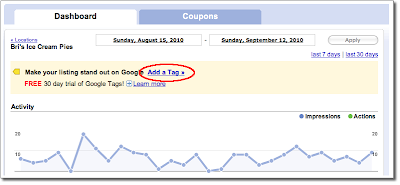
2. Select one of the seven available tag types, and follow the prompts. For example, if you choose a post tag, enter a note about the the unique aspect of your business that you want to highlight in the empty box.
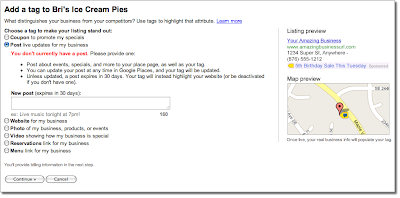
3. Enter your credit card information. If you’ve never tried Google Tags before and are eligible for the free trial, your first month will be free!
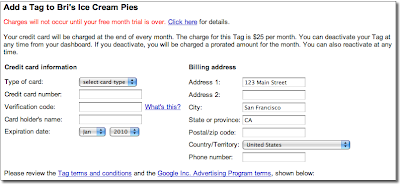
Business owners can typically complete the sign-up process in less than five minutes. With that speed, you can get back to all the other tasks that require your attention to keep growing your success!
We’re thrilled that thousands of local businesses have already been using Google Tags to attract and connect with local customers since it became available throughout the U.S. this summer. And if you’re a business owner that hasn’t yet claimed your listing in Google Places, learn more about that simple process, and then follow the same three-step tags process. This new sign-up flow is one the many features we’re working on to make the product even more efficient. As a reminder, Google Tags is usually offered for a $25 flat monthly fee, and does not affect the ranking of the business listings on Google.com or Google Maps. Try it out today!
Posted by Shalini Agarwal, Product Manager
Focusing on Our Users: The Google Health Redesign
When I relocated to New York City a few years ago, some of the most important health information for me to have on hand was my immunization history. At the time, though, my health records were scattered, and it felt like a daunting task to organize them -- a not-uncommon problem that many people face. For me, the solution came when Google Health became available in May of 2008, and I started using it to organize my health information and keep it more manageable. I also saw the potential to do much more within Google Health, such as tracking my overall fitness goals. When I joined the Google Health team as the lead user experience researcher, I was curious about the potential for Google Health to impact people’s lives beyond things like immunization tracking and how we could make the product a lot easier to use. So I set out to explore how to expand and improve Google Health.
Here at Google, we focus on the user throughout the entire product development process. So before Google Health was first launched, we interviewed many people about how they managed their medical records and other health information to better understand their needs. We then iteratively created and tested multiple concepts and designs. After our initial launch, we followed up with actual Google Health users through surveys, interviews, and usability studies to understand how well we were meeting their needs.

From this user research, we learned what was working in the product and what needed to be improved. Here are some of the things our users found especially useful:
- Organizing and tracking health-related information in a single place that is accessible from anywhere at any time
- Sharing medical records easily with loved ones and health care providers, either by allowing online access or by printing out health summaries
- Referencing rich information about health topics, aggregated from trusted sources and Google search results
Our users also described to us the benefits they saw from using Google Health:
“Google Health gives me many tools to research my prescriptions and symptoms, and to track all of the many tests I keep having. Google Health made several necessary and cumbersome tasks easy and worry free.”
“For years now, I've tried to remember my son’s allergies and medications, but the list has grown so long, that I kept forgetting one or two when a doctor asked me about them. That can't happen again because I now have a single place to keep up with them. And I love the fact that I can print off information for situations when I really need it.”
“I really like that I can share my profile with others. I want my mom to know my medical information, just in case anything ever happens to me.”
While we learned that our users were clearly getting positive results from using Google Health, our research also taught us that more was needed. We learned that we needed to make fundamental changes to fully meet the needs of all of our current and prospective users, such as those that are chronically ill, those who care for family members, and especially those users looking to track and improve their wellness and fitness.
On this last point, our user surveys already pointed out that there was more we could do to help our users track and manage their wellness, not just their sickness, so we conducted further research about how people collect, monitor, track, and analyze their wellness data. We interviewed several people in their homes and invited others into our usability labs. As a result, we identified several areas where we could improve Google Health to make it a more useful wellness tool, including:
- Dedicated wellness tracking including pre-built and custom trackers
- Efficient manual data entry as well as automatic data collection through devices
- A customizable summary dashboard of wellness and other health topics
- Goal setting and progress tracking using interactive charts
- Personalized pages for each topic with rich charts, journaling, and related information
These insights led us to a whole new set of design proposals. We gathered feedback on the resulting sketches, wire-frames, and screenshots from active and new Google Health users. The results throughout this process were eye-opening. While we were on the right track for some parts of the design, other parts had to be corrected or even redesigned. We went through several iterations until we had a design that tested well and we felt met the user needs our research had uncovered. Finally, we conducted several usability studies with a functioning prototype throughout the product development process to continuously improve usability and function.
At the end, the collaboration between the user experience, engineering, and product management teams resulted in an entirely new user experience for Google Health combined with a set of new functionality that is now available for you to try out at www.google.com/health. See for yourself how the old and new versions compare. Here is a screenshot of a health profile in the new version:

And this is how the same account and profile looked in the old user interface:

As a Google Health user, I am excited to take advantage of the new design and have already started using it for my own exercise and weight tracking. And on behalf of the user experience team and the entire Google Health team, we’re excited about being able to bring you a new design and more powerful tool that we think will meet more of your health and wellness needs.
We look forward to continuing to explore how we can make Google Health even more useful and easier to use for people like you. As you use Google Health, you may see a link to a feedback survey at the top of the application. If you do, please take the time to fill it out - we will be listening to your input!
terça-feira, 14 de setembro de 2010
How-to videos put more sexy golf carts on the road
We all have a dream. America’s 25 million small business owners are making their dreams happen. But it’s never easy.
For E.C. Hundley, his dream had four wheels, an engine, and a smooth ride. As the proprietor of Everything Carts in Martinsville, Va., E.C. built a business that custom assembles souped-up, street-legal golf carts. He also sells cart accessories online, and his business now employs eight people. With your dream, some hard work, guile and a penchant for online marketing, you can do something like this, too.
Did you get your business online from the start?
Oddly enough, we started out as a local retail store, and we never thought about taking our business online. After the first 8 months, we were going broke with just one employee, and I figured we had to do something if we were going to survive.
So you took your business online just to keep it alive.
Yes. At that point we had maybe $1,500 in inventory sitting on the shelf, so we started putting some of it on eBay. We then got with a friend who’s a web designer, and he built our website. Since then we have revamped the site about four times to make it friendly for our customers. It saved our business.
How much of your business comes from people finding you on the web, compared to other channels?
Our direct web activity is about 70% of our sales. Most of the rest is via telephone, and we also promote our business via a print catalog.
Tell us about your YouTube channel. What kind of videos do you make, and how do they help your customers?
I help people with installation of the products we sell. Our call volume had gotten really high on some of our products, so helping people over the phone was taking a lot of time. Then I remembered watching a Photoshop tutorial on YouTube, and I thought to myself this is the answer to our problem. So we started shooting a few how-to videos and posted them on our YouTube channel, and soon those calls stopped completely.
Do the videos help you sell more, too?
Yes. The videos also help us earn new business, because our customers can see that we know the products we sell, and they can buy with confidence.
What are your future plans for online video?
With the success we’ve had with the few videos we have done, we have now built a studio just for shooting how-to videos. This way the customer can see how the products are installed and get a better idea of how it is going to look. One of the toughest parts of selling a product online is that the customer usually just gets to see a picture of what they’re interested in. With video they get a better idea of the real look and size. It is the closest thing you can get to seeing, touching, feeling the product.
That’s the real power of video, isn’t it? How hard was it to get started building a YouTube channel?
It was the easiest Internet task we had ever done. It’s pretty easy and inexpensive to make good-looking videos today, too.
The main advantage of producing online videos, especially for an online business, is it makes your business real. Customers need to see that your company has real people behind the website.
Eric Meyerson, Video Business Marketing Lead recently watched "1981 primitive Internet report on KRON"
Introducing ‘Improving Online Conversions for Dummies’

segunda-feira, 13 de setembro de 2010
Discontinuous Seam Carving for Video Retargeting
Videos come in different sizes, resolutions and aspect ratios, but the device used for playback, may it be your TV, mobile phone, or laptop, only has a fixed resolution and form factor. As a result, you cannot watch your favorite old show that came in 4:3 on your new 16:9 HDTV without having black bars on the side, referred to as letterboxing. Likewise, widescreen movies and user-videos uploaded on YouTube are shot using various cameras with wide-ranging formats, so they do not fit completely on the screen. As an alternative to letterboxing, several devices try to upscale the content uniformly, which either changes the aspect ratio, making everything look stretched out, or simply crop the frame, thereby discarding any content that cannot fit the screen after scaling.
At Google Research, together with collaborators from Georgia Tech, we have developed an algorithm that resizes (or retargets) videos to fit the form factor of a given device without cropping, stretching or letterboxing. Our approach uses all of the screen’s precious pixels, while striving to deliver as much video-content of the original as possible. The result is a video that adapts to your needs, so you don’t have to adapt to the video.

Six frames from the result of our retargeting algorithm applied to a sub-clip of “Apologize”, © 2006 One Republic. Original frame is shown on the left, our resized result on the right. The original content is fit to a new aspect ratio.
The key insight is that we can separate the video into salient and non-salient content, which are then treated differently. Think of salient content as actors, faces, or structured objects, where the viewer anticipates specific, important details to perceive it as being correct and unaltered. We cannot change this content beyond uniform scaling without it being noticeable. On the other hand, non-salient content, such as sky, water or a blurry out-of-focus background can be squished or stretched without changing the overall appearance or the viewer noticing a dramatic change.
Our technique, which we call discontinuous seam carving -- named so because it modifies the video by adding or removing disconnected seams (or chains) of pixels -- allows greater freedom in the resizing process than previous approaches. By optimizing for the retargeted video to be consistent with the original, we carefully preserve the shape and motion of the salient content while being less restrictive with non-salient content. The key innovations of our research include: (a) a solution that maintains temporal continuity of the video in addition to preserving its spatial structure, (b) space-time smoothing for automatic as well as interactive (user-guided) salient content selection, and (c) sequential frame-by-frame processing conducive for arbitrary length and streaming video. The outcome is a scalable system capable of retargeting videos featuring complex motions of actors and cameras, highly dynamic content and camera shake. For more details, please refer to our paper or visit the project web-site.
sexta-feira, 10 de setembro de 2010
Google Places Brings a Smile to a Dental Practice
Challenge
Dentists primarily rely on word-of-mouth referrals from existing patients, but they’re also open to welcoming new patients from other sources. That’s why Dr. Prager was intrigued when one of his patients suggested that he check out Google Places as a way to build an online presence for his dental care practice, Bellingham Smiles.
Action
Realizing that he could have his business listing appear for free when people searched on Google.com or Google Maps for services like “dentist in bellingham,” Dr. Prager claimed his listing and built out the Place page for his business. As his practice continues to evolve, he updates the Place page for Bellingham Smiles to reflect new treatments and promotional offers. For example, from time to time, he adds a new video or updates his business description. “It’s best to stay on top of it and modify it as you add new services and any new emphasis in your practice,” he says.
In many cases, patients come to him via his Place page in hopes that he can save a tooth that has been targeted for extraction by another dentist. It also helps him publicize his niche expertise in laser procedures that help patients avoid painful gum surgery.
Results
The free business listing and Place page that Dr. Prager set up through Google Places have become his marketing powerhouse. “It’s the highest return on investment (ROI) of any marketing that I do. That’s pretty powerful since I do a lot of marketing,” he says. “Google Places has been very helpful in getting people who want to save their natural teeth to find me. The thing that counts in marketing isn’t what you spend, it’s the ROI. I would say Google, in all of its forms, is our best ROI.”
Now aware that a strong online presence is essential to helping people find him, Dr. Prager urges other businesses to take advantage of Google Places as well. “If you’re not listed on Google somewhere, you are invisible to potential clients, patients and customers,” he says. “A lot of people will not go to a business of any kind if they don’t have a website. They want information before they call or visit. That trend is only going to increase.”
To create a Google Places account for your business, visit www.google.com/places.
Posted by Bernadette Cay, Associate Product Marketing Manager
Going Google across the 50 States: Google Apps and Google App Engine are a powerful combination for West Virginia business
quinta-feira, 9 de setembro de 2010
Google Search by Voice: A Case Study
Wind the clock back two years with your smart phone in hand. Try to recall doing a search for a restaurant or the latest scores of your favorite sports team. If you’re like me you probably won’t even bother, or you’ll suffer with tiny keys or fat fingers on a touch screen. With Google Search by Voice all that has changed. Now you just tap the microphone, speak, and within seconds you see the result. No more fat fingers.
Google Search by Voice is a result of many years of investment in speech at Google. We started by building our own recognizer (aka GReco ) from the ground up. Our first foray in search by voice was doing local searches with GOOG-411. Then, in November 2008, we launched Google Search by Voice. Now you can search the entire Web using your voice.
What makes search by voice really interesting is that it requires much more than a just good speech recognizer. You also need a good user interface and a good phone like an Android in the hands of millions of people. Besides the excellent computational platform and data availability, the project succeeded due to Google’s culture built around teams that wholeheartedly tackle such challenges with the conviction that they will set a new bar.
In our book chapter, “Google Search by Voice: A Case Study”, we describe the basic technology, the supporting technologies, and the user interface design behind Google Search by Voice. We describe how we built it and what lessons we have learned. As the product required many helping hands to build, this chapter required many helping hands to write. We believe it provides a valuable contribution to the academic community.
The book, Advances in Speech Recognition, is available for purchase from Springer.
The AdWords Small Business Center: the key tips, tutorials, and updates you need for a successful AdWords account









